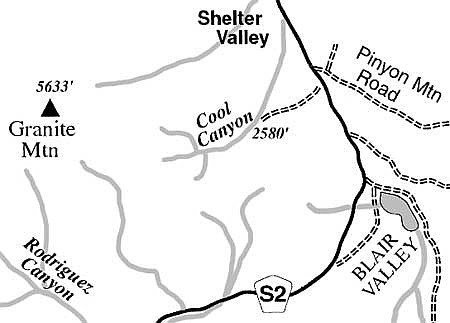 Facebook
Facebook
 X
X
 Instagram
Instagram
 TikTok
TikTok
 Youtube
Youtube
Cool Canyon, a deep crease in the east flank of Granite Mountain, stays truly cool only for a month or two before winter solstice, and for a couple of months afterward. If you visit the place anytime soon, expect temperatures to be hot in the midday -- but pleasantly warmish once the sun goes down over the mountain, by 4 p.m. or so in the month of October.
Botany buffs consider Cool Canyon a hot spot for viewing transitional low-desert/high-desert vegetation. Also, the canyon's off-the-beaten-track locale and intimate setting nearly always pleases those seeking quietude.
The canyon is easily accessible for those traveling east from Julian or Cuyamaca. At Scissors Crossing (12 miles east of Julian via Highway 78), turn southeast on Highway S-2 and drive about 5 miles. At mile marker 21.5, find the unsigned access road to Cool Canyon on the right. Drive one mile up the sandy road to where it ends, just short of the mouth of Cool Canyon.
From the end of that road, descend on foot into the sandy wash just north and follow it west through a narrow portal. Grayish granitic and variegated tan-colored metamorphic rocks (a local type called Julian schist) form the walls and floor of the canyon. Thorny desert apricot bushes grow along the wash bottom, and the slopes are thickly covered with brittlebush, a big producer of yellow, daisylike flowers in early spring. After significant rainfall (typically by January or February), mosses and green grass thrive in the shady spots. Not much green or floral colors can be seen in the fall season, but the discerning eye can at least easily spot specimens of nearly all common types of Anza-Borrego-dwelling cactuses, either right down on the canyon bottom, or higher up on the slopes.
For the purpose of this moderate-difficulty hike, you can proceed up the canyon for a total of a mile. Here and there you'll encounter some minor climbing challenges in the form of tilted rock slabs and small dropoffs that desert hikers call "dry falls."
At 0.9 mile into the hike, note the narrow canyon coming in from the south. A fine, large specimen of mountain manzanita lies a short distance up this canyon. A bit higher and farther west of this juncture, the main canyon divides, with a west branch going straight and a northwest branch going to the right. A scramble up the right branch takes you over a tall, steep, dry fall -- a fun climb that nets you a better view of the surrounding landscape and its chaparral-like vegetation, which includes scrub oak and juniper. This is a good spot to rest before starting your return trip.
This article contains information about a publicly owned recreation or wilderness area. Trails and pathways are not necessarily marked. Conditions can change rapidly. Hikers should be properly equipped and have safety and navigational skills. The Reader and Jerry Schad assume no responsibility for any adverse experience.


Cool Canyon, a deep crease in the east flank of Granite Mountain, stays truly cool only for a month or two before winter solstice, and for a couple of months afterward. If you visit the place anytime soon, expect temperatures to be hot in the midday -- but pleasantly warmish once the sun goes down over the mountain, by 4 p.m. or so in the month of October.
Botany buffs consider Cool Canyon a hot spot for viewing transitional low-desert/high-desert vegetation. Also, the canyon's off-the-beaten-track locale and intimate setting nearly always pleases those seeking quietude.
The canyon is easily accessible for those traveling east from Julian or Cuyamaca. At Scissors Crossing (12 miles east of Julian via Highway 78), turn southeast on Highway S-2 and drive about 5 miles. At mile marker 21.5, find the unsigned access road to Cool Canyon on the right. Drive one mile up the sandy road to where it ends, just short of the mouth of Cool Canyon.
From the end of that road, descend on foot into the sandy wash just north and follow it west through a narrow portal. Grayish granitic and variegated tan-colored metamorphic rocks (a local type called Julian schist) form the walls and floor of the canyon. Thorny desert apricot bushes grow along the wash bottom, and the slopes are thickly covered with brittlebush, a big producer of yellow, daisylike flowers in early spring. After significant rainfall (typically by January or February), mosses and green grass thrive in the shady spots. Not much green or floral colors can be seen in the fall season, but the discerning eye can at least easily spot specimens of nearly all common types of Anza-Borrego-dwelling cactuses, either right down on the canyon bottom, or higher up on the slopes.
For the purpose of this moderate-difficulty hike, you can proceed up the canyon for a total of a mile. Here and there you'll encounter some minor climbing challenges in the form of tilted rock slabs and small dropoffs that desert hikers call "dry falls."
At 0.9 mile into the hike, note the narrow canyon coming in from the south. A fine, large specimen of mountain manzanita lies a short distance up this canyon. A bit higher and farther west of this juncture, the main canyon divides, with a west branch going straight and a northwest branch going to the right. A scramble up the right branch takes you over a tall, steep, dry fall -- a fun climb that nets you a better view of the surrounding landscape and its chaparral-like vegetation, which includes scrub oak and juniper. This is a good spot to rest before starting your return trip.
This article contains information about a publicly owned recreation or wilderness area. Trails and pathways are not necessarily marked. Conditions can change rapidly. Hikers should be properly equipped and have safety and navigational skills. The Reader and Jerry Schad assume no responsibility for any adverse experience.
